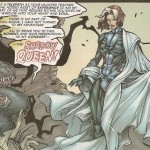With a variety of artist collaborators, Chris Claremont wrote the X-Men for sixteen straight years, and then came back later for more. Frost & Lynch’s Twin Peaks had a much shorter run, but is currently readying itself for a return. Both are definitive examples of whatever they are—imperfect, but unputdownable—and there is more than one place in which the two properties pleasingly overlap. Shall we compare? Yes, let’s.
A Clone Called Maddy
So your dream girl is dead, and kind of frightening in hindsight. Well, that’s okay. That’s okay! It’s sad, but (your) life goes on. And guess what? Guess who’s coming to dinner? It’s a chick who looks a heck of a lot familiar. What’s her name? Madeleine? Madelyn? Maddie with a y? Right…
In Twin Peaks, Laura Palmer’s cousin Madeleine Ferguson arrives to stay with her aunt and uncle in the wake of Laura’s murder. Evoking strong, attractive, remembrance feelings in a number of those who cared for her predecessor, Maddy manages to avoid full entanglement with Laura’s secret boyfriend James (some might call it a close thing). Her story isn’t exactly one of great luck from there on. She’s a sugar-sweet well-meaning type, and coming to Twin Peaks was the worst thing that could have happened to her.
Similarly, Madelyn Pryor’s involvement with the X-Men—with Scott Summers, devoted leader thereof—led her to horror, torment, existential dissolve and death. Originally intended as a simply coincidental doppelgänger to the recently deceased Phoenix, Jean Grey, Madelyn’s story unfolded to include the revelation that she was a tube-grown literal clone. Losing her husband to his work and then his ex, taunted into supervillainy and defeat, her humiliations didn’t even end in death; the resurrected Jean took delivery of all of Maddy’s memories, returned to Scott, and raised her son with him, leaving Madelyn nothing of her own at all.
The Red Hot Room
You know that heavily themed room you go to sometimes, to commune with your mystic otherself and sort out what’s real, what’s metaphorical, what’s happened and what’s happening? It’s a heavy trip, but it’s useful. It’s frightening, but it’s security, too.
Twin Peaks‘ Agent Dale Cooper has a place he visits in dreams, to scry for clues. Sometimes he’s visited by supernatural elements—or are they just a system he uses to sort out supposition from observation? It doesn’t matter; the viewer sees them, and he talks about them to colleagues as if they’re individuals. The red room is iconic. It’s even been seen on Scooby Doo.
The White Hot Room, on the other hand, is a liminal place for Phoenix hosts, or forms, or…whatever Phoenixes are whenever the room is being used. Marvel wikia has it as a place that “serves both as the afterlife and a base of operations for the Phoenix.” In the early days, though, the Claremont days, the Jean personality was able to visit this place to compare her various selves, attempting to find a balance between human and cosmic goddess.
Donna Does Malice
Good, nice girl, long in the support role; appreciated, but not prioritised. All of a sudden she’s mean, and selfish, and conniving, acting out and affecting a parodic sexuality. What’s up with that? Is she just turned bitch?
Claremont and Romita Jr invented Malice in Uncanny #210. Essentially a personified anxiety disorder, Malice is a mutant with no body of her own and must exist as a parasite. She’s not a very nice person, and preys on the weaknesses, insecurities, complexes and desires of her captured hosts to turn them, basically, horrible. Under Malice’s control Dazzler attempts to oust Lila Cheney, the intergalactic rockstar who’s harbouring mutant-in-hiding Dazzler in her backing band and endangers the whole crew of their tour. From here she made a ruckus and burned through the X-Men until finding a spot she liked in Lorna Dane, also known as Polaris. Polaris has a long-standing romantic relationship with Havok…whose civilian name is Alex Summers. Yes, Lorna loves a Summers boy, so she has plenty of angst and plenty of strife (although thankfully, no Stryfe) for Malice to kick around. Through Lorna Malice is given to calling people Lover and wearing great big pointy shoulders.
Donna, for her part, is not possessed by any of the spiritual beasties lurking around the falls and forests of Twin Peaks. Probably not. We’re never told that she is. But something changes for this girl—she starts out fuzzy, calf-length, chunky-knit and buttoned and right on the cusp of the second season, “inexplicably discovers her inner femme fatale,” in the words of our Kayleigh Hearn. Donna gets mean, she gets selfish, she gets careless, and with her newfound arch attitude she contributes to the suicide of a creepy but obviously vulnerable person. If only the sudden change could be attributed to a psychic stowaway, I’d feel better for the sudden tip-over of this good girl turned problematic fave o’ mine.
Suddenly Yellowface
I’m not going to couch this one in jokes: both stories take a white person and put an Asian identity on them.
Early in the second season of Twin Peaks Catherine Martell’s “disappearance” is immediately explained by the arrival of “Mr. Tojamura,” a fake name for a fake person. Catherine’s yellowface is all makeup and accent, and once she gets bored of her subterfuge, “he” is discarded.
Over in Uncanny X-Men #256, white English X-Man Betsy Braddock stepped into the Siege Perilous…and vanished. She emerged into a dream sequence which is understood by the chronological reader as her zonked-out understanding of a real procedure; the goo used to mould her face into new shapes seems to be real enough. Who knows what tools Mojo has at his disposal. Later events would re-explain this as the merging and re-separation of the Betsy and Kwannon bodies and minds (wiki it). Either way, “Betsy Braddock a.k.a. Psylocke” went from being a successful white model and warrior-mutant, to being a “Japanese” assassin known as Lady Mandarin.
KING BOB
Fear turned into cruelty: the terror of secret human possibility. But magic, though. A wardable evil, eventually.
The Handbook of the Marvel Universe has the Shadow King down as a “manifestation of the dark side of the human consciousnesses, spawned by the first nightmare.” Over in Twin Peaks, Bob is “a manifestation of ‘the evil that men do.'” Spoilers now, so look away, pretty innocents.
The Shadow King takes mental possession of people in much the same was as Malice, but the Shadow King is stronger. You can argue with Malice—she can’t control you, she can only goad and trick you. You’ve no idea that the Shadow King has started creeping into your psyche, and you can’t control what he makes you do. Maybe you don’t even know he’s there with you, it’s really up to him. Sometimes he likes to taunt the people who know he’s there. The Shadow King indulges in attempts at murder, suppression and violation, and is apparently immortal.
Meanwhile Bob arrives in Twin Peaks having jammed himself into Leland Palmer’s mind as a child, and uses him to sexually abuse and murder his own daughter and, later, her cousin. Man abused as child experiences personality break and grows up tragically unaware of his own appalling domestic betrayals is a recognisable revelation from crime fiction, but Twin Peaks achieves its unusual elegance and lasting identity by taking all the supernatural bombast and creative spirituality of Claremont’s X-Men, adding it to a regular or realistic narrative scaffold, and refusing to disavow anything.














